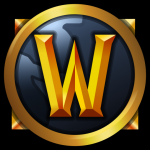 My morning class went much more smoothly today. I had a talk with the student whose account lost characters and reviewed the need to not delete characters. I’m not sure he deleted the characters. As I played on two different computers today but the time I went to the second computer World of Warcraft started me on a server where I had no characters so it looked, at first glance, as though my characters were deleted! When I went back to Sisters of Elune my two characters (morning class, Horde, and afternoon class, Alliance) were there. Whew! When I looked at the student who was on a server with no characters, he was on Sisters of Elune but I didn’t check to see if his character was on another server. As I recall just now students were having problems starting characters on the correct server. I need to check into this some more before I figure out what the problem is.
My morning class went much more smoothly today. I had a talk with the student whose account lost characters and reviewed the need to not delete characters. I’m not sure he deleted the characters. As I played on two different computers today but the time I went to the second computer World of Warcraft started me on a server where I had no characters so it looked, at first glance, as though my characters were deleted! When I went back to Sisters of Elune my two characters (morning class, Horde, and afternoon class, Alliance) were there. Whew! When I looked at the student who was on a server with no characters, he was on Sisters of Elune but I didn’t check to see if his character was on another server. As I recall just now students were having problems starting characters on the correct server. I need to check into this some more before I figure out what the problem is.
My morning class played rather well together. Kids were helping each other out and they didn’t need me much so I was able to play a little leveling up my Undead Priest to level 6 (which means I got the Shield spell for those of you familiar with WoW!). My afternoon class needed help but several students kept asking me for help. I was actually quite amazed that students aren’t figuring this game out for themselves. Some of the things they needed help with were issues that an experienced player would know so I was quite helpful. Some of the issues I thought were more of the “look around and try different things to figure it out” variety. Either way many of the issues could have been dealt with by asking peers instead of me. I mean, it felt good being needed but I was hoping for more cooperation like with my morning class. Some kids in the afternoon were helping each other and they didn’t need me at all. I’m curious to see if this improves.
In terms of standards, since the Next Generation Science Standards (NGSS) don’t have a standard for classifying living things I had to look beyond that. Why do students need to practice classifying living things, or even what benefit will they get by engaging in this activity besides just having fun playing WoW? My plan is to connect their experiences classifying living things in the simulated world to how to scientists actually classify living things on Earth to lead them to our study of Structure and Function. The NGSS has a standard for the study of Structure and Function, specifically:
Structure and Function
Complex and microscopic structures and systems can be visualized, modeled, and used to describe how their function depends on the relationships among its parts, therefore complex natural structures/systems can be analyzed to determine how they function. (MS-LS1-2)
But I also found technology standards that apply to the work we’re doing by playing WoW. Looking at the ISTE tech standards I came across the following:
ISTE Standards Profile (pdf file by grade band):
The following experiences with technology and digital resources are examples of learning activities in which students might engage during Grades 6–8 (ages 11–14):
1. Describe and illustrate a content-related concept or process using a model, simulation, or concept-mapping software. (Connected to the following standards – 1. Creativity and Innovation and 2. Communication and Collaboration)
From the ISTE Standards (pdf file)
1. Creativity and Innovation
Students demonstrate creative thinking, construct knowledge, and develop innovative products and processes using technology.
a. Apply existing knowledge to generate new ideas, products, or processes
b. Create original works as a means of personal or group expression
c. Use models and simulations to explore complex systems and issues
d. Identify trends and forecast possibilities
 2. Communication and Collaboration
Students use digital media and environments to communicate and work collaboratively, including at a distance, to support individual learning and contribute to the learning of others.
a. Interact, collaborate, and publish with peers, experts, or others employing a variety of digital environments and media
b. Communicate information and ideas effectively to multiple audiences using a variety of media and formats
c. Develop cultural understanding and global awareness by engaging with learners of other cultures
d. Contribute to project teams to produce original works or solve problems
I think those fit pretty well.







































































